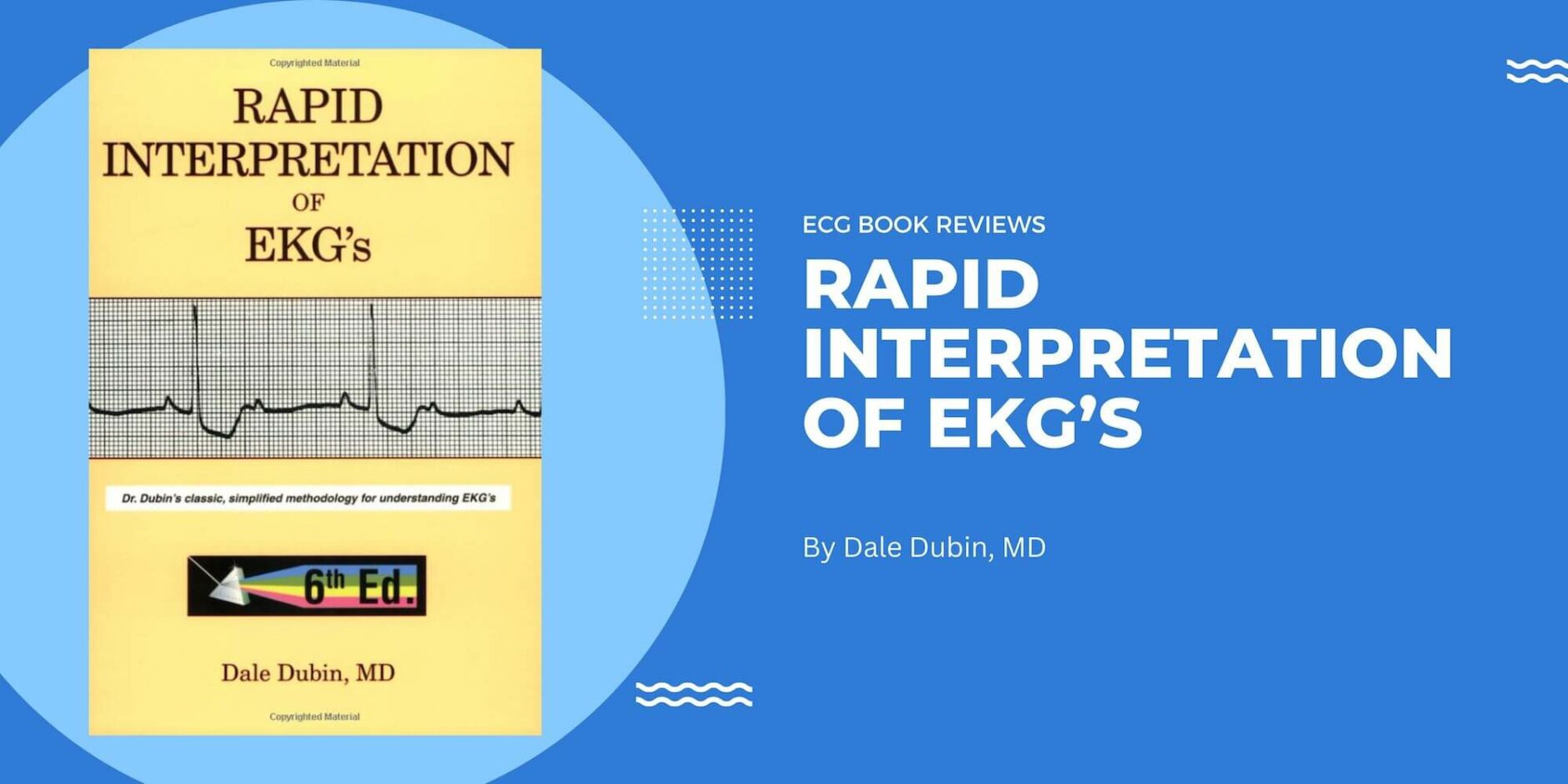Dale Dubin’s book, Rapid Interpretation of EKG’s, is a best-selling textbook that has been used for over 30 years to teach the basics of interpreting electrocardiograms. The book is designed to help readers rapidly assimilate medical concepts and understand the key principles of EKG interpretation.
The book, first published in 1972 by Dr. Dale Dubin, a cardiologist from Florida, has been continuously updated and currently stands at its 6th edition. It provides clear and concise explanations and easy-to-understand illustrations for readers to quickly and accurately interpret EKGs.
An Overview Of Dale Dubin’s Rapid Interpretation Of EKGs
Rapid Interpretation of EKGs by Dale Dubin is a comprehensive guide to understanding and interpreting electrocardiograms. It provides a thorough overview, from the essentials of cardiac anatomy to distinguishing arrhythmias. This book covers various topics related to ECG interpretation, including normal sinus rhythm, atrial rhythms, ventricular rhythms, and more.
In addition to providing information on how to read an ECG correctly, this book also offers helpful tips on how to interpret them quickly without sacrificing accuracy. For example, it suggests focusing first on rate before rhythm when reading an ECG strip to get a general idea of what is going on before delving into more complicated aspects like P waves or QRS complexes.
The book also provides a five-step method for reading an EKG strip, which includes identifying and examining the P waves, measuring the PR interval, measuring the QRS complex, identifying the rhythm, and determining the heart rate. Additionally, the book covers the different heart conditions that can be detected through EKG interpretation, such as arrhythmias, myocardial infarction, and atrial fibrillation.
Dale Dubin is a renowned cardiologist and the author of Rapid Interpretation of EKGs. He received his medical degree from Indiana University Medical School in 1965. He has shared his expertise on cardiac care through lectures at various medical meetings globally, garnering him recognition as an international speaker.
Dubin’s experience as an emergency room physician led him to develop a method for quickly interpreting electrocardiograms (EKG). This method was published under the title Rapid Interpretation of EKG’s: An Interactive Course and has since become one of the most popular books on ECG interpretation among medical professionals worldwide.
What’s Covered In Rapid Interpretation Of EKG’s
The book was first published in 1972 as a paperback by Cover Publishing Company. It quickly became popular among medical professionals due to its clear explanations, easy-to-follow illustrations, and practical tips for interpreting ECGs quickly and accurately. Since then, it has gone through multiple editions with updated information on new technologies, such as computerized ECG machines.
Through the years, Rapid Interpretation of EKG’s has become a globally sought-after reference for hospital personnel attempting to interpret electrocardiograms. It’s recommended reading for nursing students studying electrocardiography and doctors looking to advance their career or earn more money by becoming proficient at interpreting ECGs quickly and accurately.
This work provides a comprehensive overview of the topics explored, alongside examples and visual aids, which can help users rapidly comprehend electrocardiogram interpretation. It also provides tips for interpreting EKGs quickly and accurately. Some topics covered in Rapid Interpretation of EKG’s include normal sinus rhythms, cardiac axis, bundle branch blocks, and more.
Normal Sinus Rhythm
The normal sinus rhythm is the most common type of heart rhythm. It’s characterized by a regular pattern of electrical activity that originates in the sinoatrial (SA) node located in the right atrium. This electrical activity causes the contraction of both atria and ventricles, resulting in a coordinated pumping action.
In the book, Dublin explains how to identify this rhythm on an ECG strip using P-waves (atrial depolarization), QRS complexes (ventricular depolarization), and T-waves (ventricular repolarization).
Cardiac Axis
Cardiac axis refers to the direction or orientation of electrical impulses generated by cardiac muscle cells during depolarization. When observed front-to-back, an imaginary line running from left to right through the heart’s chambers can be conceived of as a representation of the cardiac axis. This helps determine whether an ECG reading indicates normal or abnormal functioning within the heart’s conduction system.
Dublin discusses various methods to calculate the cardiac axis, such as vector analysis or lead placement technique. Additionally, he covers abnormalities associated with abnormal axes like left anterior fascicular block or left posterior fasciuclar block.
Bundle Branch Blocks
Bundle branch blocks refer to abnormalities in how signals travel through either one or both bundle branches. These pathways carry electrical signals from the AV node to other parts of your heart muscle for contraction purposes. A block can arise when the pathways which carry electrical signals from the AV node to other parts of your heart muscle become obstructed due to disease.
The two main types of bundle branch blocks are left bundle branch block (LBBB) and right bande branch bock (RBBB). Dublin explains what these blocks look like on an ECG strip, their causes, and available treatments. He also provides tips for distinguishing between LBBB vs. RBBB using certain criteria like morphology or duration of QRS complex.
Atrial And Ventricular Tachyarrhythmias
Atrial and ventricular tachyarrhythmias are rapid heartbeat patterns from different heart areas. These two types can be further divided into subtypes based on their characteristics, such as duration and frequency. They may also require distinct treatment approaches depending on individual cases, so accurate diagnosis is essential for formulating effective management plans.
Dublin covers a range of atrial tachyarrhythmias, such as SVT, MAT, and AVNRT, and ventricular tachyarrhythias, such as VT and Vfb. He explains how they can be identified by looking for specific features in each type’s respective ECG strips, like the presence or absence of a P-wave preceding every QRS complex.
Rapid Interpretation Of EKGs In The Classroom
In the classroom setting, Rapid Interpretation of EKG’s has been used as a primary textbook for teaching students about ECG interpretation for over 30 years. Lectures are typically based on each chapter’s content, with additional information provided through supplementary materials such as videos or slideshows from online sources like YouTube or PowerPoint presentations. Some programs have permission to use a Rapid Interpretation of EKG’s pdf. In these situations, professors will provide students with a Rapid Interpretation of EKGs Dubin PDF free download, and the school pays the fees for the PDF license. Keep in mind if your school has not licensed the PDF, it is not legal to use a copy of the PDF.
During class discussions, teachers will often use examples from real-life cases to help students better understand how to apply their knowledge when interpreting actual patient data in clinical settings later on down the line.
Other Helpful ECG Interpretation Resources
For those looking to enhance their understanding of ECG interpretation, a wealth of options exist.
One such resource is The 12 Lead ECG in Acute Coronary Syndromes by Tim Phalen and Barbara Aehlert. This book covers all aspects of acute coronary syndrome diagnosis using 12 lead ECGs, including ST-segment elevation myocardial infarction (STEMI) and non-ST segment elevation myocardial infarction (NSTEMI). It further furnishes a series of quizzes to appraise one’s comprehension at the culmination of each chapter.
Another helpful resource is Understanding Arrhythmias: An Interactive Course by Mary Boudreau Conover. This interactive course utilizes animations and illustrations to explain arrhythmia concepts in an accessible manner. It also has practice tests so you can check your understanding after completing each lesson.
Finally, online platforms like ECGEDU.com offer comprehensive courses on interpreting EKGs and practice tests and quizzes to help medical professionals better understand how to interpret an EKG accurately and quickly. These courses provide detailed explanations about different types of arrhythmias and audio recordings from actual patients so you can get used to recognizing them in real-life scenarios.
Practice ECG Interpretation Online At ECGEDU.com
If you’re looking for a way to practice ECG interpretation online, ECGEDU has self-paced video courses with interactive videos with detailed illustrations that make learning electrocardiogram interpretation simple and understandable. Sign up today and start mastering rapid EKG interpretation.




